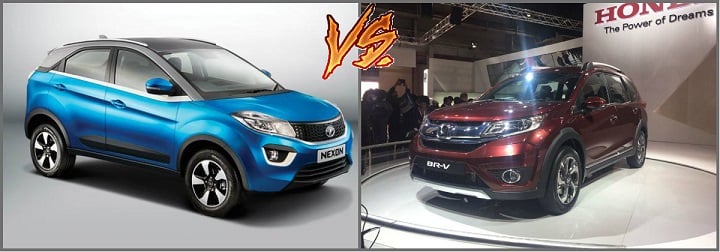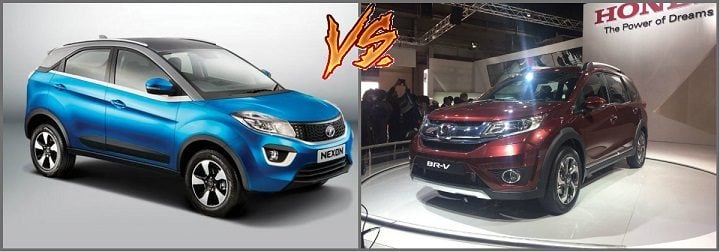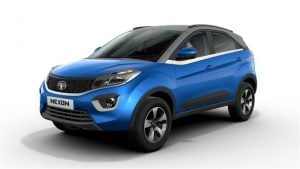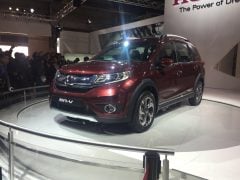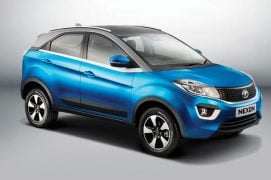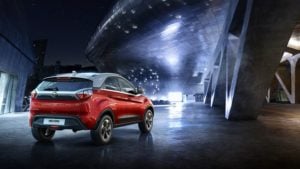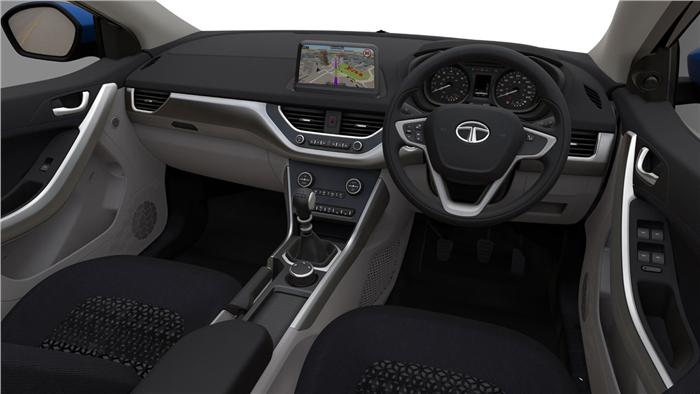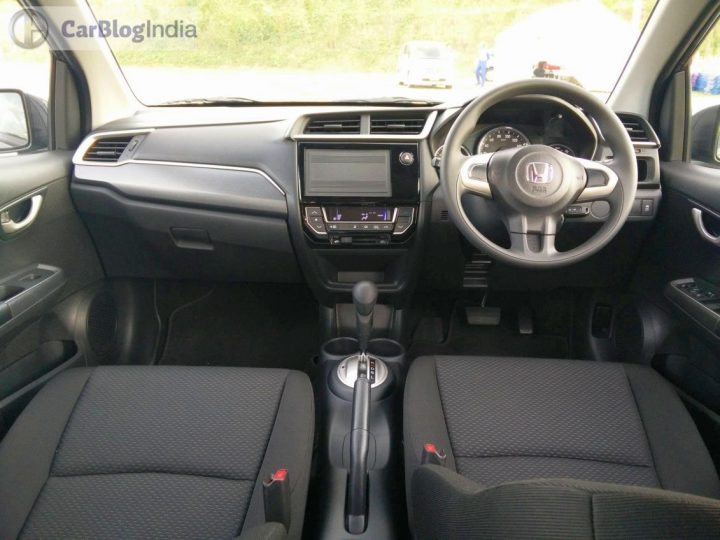Tata Motors has just launched the Nexon compact crossover in India. While the new model will compete with many other models in its price segment, an indirect rival is the Honda BRV. You may say that it has more seating inside and hence, it does not compete with the Nexon. However, both cars are crossovers. Both cars cost under 10 lakh (BRV does, Nexon too). Hence, buyers will give both cars a long, hard look before deciding on either. So, we thought why not make your task simple and compare the two cars. With that in mind, here’s our Tata Nexon vs Honda BRV comparison for you. We hope this comparison helps you decide which one of the two car you should buy.
Also Read: Tata Nexon Test Drive Review | Tata Nexon AMT Coming Soon
Tata Nexon vs Honda BRV – Price Comparison
| Tata Nexon Price | ₹ 5.85 lakh – 9.45 lakh |
| Honda BRV Price | ₹ 8.93 lakh – 13.04 lakh |
*all prices ex-showroom Delhi
Since the Tata Nexon sits in half a segment lower, it has clear price advantage. The Nexon has a huge price advantage over all its immediate rivals. No surprise then, that, it ends up having a much bigger price advantage over the BRV. You can now see the reason behind this comparison. The Nexon has a starting price of Rs 5.85 lakh, while the most expensive model costs Rs 9.45 lakh. The BRV’s price starts from Rs 8.93 lakh, a point where it intersects the price range of the Nexon.
Also Read: Tata Nexon vs Honda WRV | Tata Nexon vs Hyundai Creta | Tata Nexon vs Maruti Ignis
Tata Nexon vs Honda BRV – Specifications Comparison
Petrol
| Specifications | Tata Nexon | Honda BRV |
| Engine | 1.2-litre turbo petrol | 1.5-litre petrol |
| Power | 108BHP | 117BHP |
| Torque | 170Nm | 145Nm |
| Transmission | 6-speed manual | 6-speed manual/CVT automatic |
The Tata compact SUV comes packing a turbocharged RevoTron petrol engine that displaces 1.2 litres. This engine makes 108BHP of peak power and 170Nm of peak torque and is paired with a 6-speed manual. The BRV, on the other hand, has the 1.5-litre i-VTEC petrol engine that makes 117BHP and 145Nm torque. This engine is mated to either a 6-speed manual gearbox or an optional CVT transmission.
Also Read: Tata Nexon vs Ford EcoSport | Tata Nexon vs Maruti Vitara Brezza
Diesel
| Specifications | Tata Nexon | Honda BRV |
| Engine | 1.5-litre turbo diesel | 1.5-litre turbo diesel |
| Power | 108BHP | 100BHP |
| Torque | 260Nm | 200Nm |
| Transmission | 6-speed manual | 6-speed manual |
When it comes to diesel engines, both cars are quite even until you consider their torque outputs. The Nexon comes with a turbocharged RevoTorq diesel engine that displaces 1.5 litres. This engine has a peak power output of 108BHP and peak torque output of 260Nm. Transmission duties on the Nexon diesel are handled by a 6-speed manual gearbox. The BRV comes with a 1.5-litre iDTEC turbo diesel engine that makes 100BHP power and 200Nm torque. This engine comes with a 6-speed manual gearbox as the only transmission choice.
Tata Nexon vs Honda BRV – Mileage Comparison
| Car | Mileage* (petrol) | Mileage* (diesel) |
| Tata Nexon | 17 KMPL | 21.5 KMPL |
| Honda BRV | 16 KMPL (MT)/15.4 KMPL (AT) | 21.9 KMPL |
*ARAI-certified
The Nexon enjoys a clear advantage when it comes to mileage from the petrol engine variants. It lags a little when it comes to comparison of Diesel engines in terms of mileage. However, let’s not forget that it is more powerful and even then offers almost the same mileage.
Tata Nexon vs Honda BRV – Dimensions Comparison
| Dimensions | Tata Nexon | Honda BRV |
| Length (mm) | 3,995 | 4,456 |
| Width (mm) | 1,811 | 1,735 |
| Height (mm) | 1,607 | 1,666 |
| Wheelbase (mm) | 2,498 | 2,662 |
Since the BRV has more seating than the Nexon, it is naturally longer than the Tata crossover. However, while the BRV is 461mm longer than the Nexon, its wheelbase is just 164mm longer than Nexon’s. The Nexon, at 1,811mm, is 76mm wider than the BRV. The BRV, at 1666mm, is taller than Nexon by 59mm. This means that while BRV has more headroom than Nexon, the Nexon should be a more nimble car.
Tata Nexon vs Honda BRV – Features
| Tata Nexon | Honda BRV |
| Touchscreen infotainment unit | Projector headlamps |
| Projector headlamps with LED DRLs | Seating for 7 |
| Dual-tone exterior | 2nd row roof A/c vents |
| Dual-tone interior | 2nd row reclining seats |
| 8-speaker audio system | 3rd row reclining seats |
| 17-inch alloy wheels | 16-inch alloy wheels |
In terms of features, the Nexon is better equipped than the BRV. The BRV’s list of features is quite long too. Some curios omissions on the BRV are that of LED DRLs, dual-tone dashboard, multiple driving modes, cooled glovebox, and addition of 16-inch wheels. Also, it does not have a match for Nexon’s 8-speaker audio system.
Tata Nexon vs Honda BRV – Exterior Design
The Tata Nexon’s design is muscular but lean, which is what makes it look so nice. Praise also goes to the styling elements of the car that make it look upmarket but not overly so. The wide grille that merges neatly into the headlamps and has chrome running across the top and bottom edges looks understated yet expensive. The dual-tone exterior of the car also helps it stand out quite nicely. The side is neat and is coupe-like roofline makes it look sporty. At the rear, the taillamps flanked by the chrome strip running across the width of the car look great. In essence, this car has a cohesive design that will find a number of takers.
The BRV is based on the same platform as the Brio. As a result, you can see the hints of the small car on this 7-seater too. Honda has tried to hide the Brio effect by throwing in different styling elements. Up front, these styling elements give the car a confused sense of purpose. The chrome strip on the grille and around fog lamp housings tries to make this car look expensive. However, the faux skid plate tries to establish this car’s off-road credentials. If you remove the body cladding on the sides, this car looks identical to the recently-discontinued Mobilio. The upright rear windscreen makes the rear of the car stand out (not in a nice way). The LED taillamps, that run from across the width of the car are a nice touch. However, the chrome applique on number plate housing and rear faux skid plate again ruin its looks.
Tata Nexon vs Honda BRV – Interior Design
The Nexon’s dual-tone black-grey interior gives the interior an air of spaciousness. The brushed aluminium inserts on the dashboard, steering wheel and door trims add to the spaciousness. The centre console is clutter-free and a floating infotainment unit is the highlight here. It seems as if Tata was working on a minimalistic design for the interior of this car. The clutter-free arrangement of button and around the dashboard will appeal to a lot of buyers, which is a victory for Tata.
Being based on the Brio platform, anyone who has ever taken seat in a Brio/Amaze/Mobilio will instantly recognise this interior. The interior of this car gives an ordinary impression of the car, which will offend few. However, Honda missed a big opportunity here. Those who don’t like the Brio/Amaze/Mobilio interior will not like this interior too. Here’s the reason why we say so. The BRV’s interior is dominated by black colour. There are brushed aluminium inserts on the dashboard and on the steering wheel of the BRV. However, when it comes to switchgear, the BRV’s switches will remind you of its Brio-platform siblings. On a car costing as much as the BRV, Honda could have done better.
Tata Nexon vs Honda BRV – Conclusion
Price – Both cars sit in different price brackets. After all, the Nexon is a sub-4m SUV while the Creta is longer than 4 metres. Hence, Nexon naturally has the clear edge here.
Specifications – The Nexon’s engines are a good match for BRV’s. Slightly down on power, the Nexon’s petrol engine offers more torque that BRV’s bigger engine. When it comes to diesel engines, the Nexon’s motor easily outguns the BRV’s in torque output.
Mileage – The two cars’ compare against each other quite nicely in this respect too. However, it is the petrol Nexon that offers a higher mileage. The Diesel Nexon offers a slightly lower mileage but let’s not forget it has a power advantage.
Dimensions – The Nexon offers more elbow room but less legroom and headroom than BRV. The BRV may be longer than Nexon, but it has to seat 7. This means both cars’ cabins offer similar levels of legroom in the second row (the Nexon may offer more). Offering more elbow room means the Nexon will be able to accommodate the generously-proportioned folks easily. Low height on Nexon will likely translate in better driving dynamics than those of BRV.
Features – The Nexon enjoys a clear edge here.
Design – The Nexon’s design feels cohesive inside out. It tries to drive home the point that it is an up-market product and the interior and exterior design conveys that point succinctly. The BRV’s exterior design feels confusing due to the use of rugged styling elements. This is the case when the car has quite a bit of chrome to show all around. Inside, the car’s design is nothing new and the switchgear is a carryover from Brio/Amaze/Mobilio.
So, do you like our Tata Nexon vs Honda BRV comparison? Feel free to mention your thoughts in the comments below. For more such stories, stay tuned to Car Blog India.

